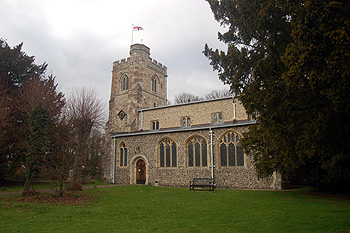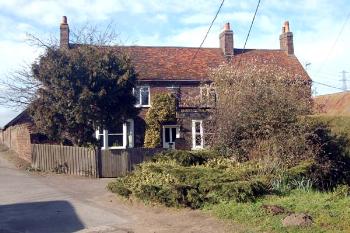The Community of Caddington in General

The approximate site of Caddington Windmill March 2007
Landscape
Caddington lies on the north-east edge of the Chiltern Hills. The highest ground lies to the north with steep drops to north and north-west and a more gradual drop south-east. The landscape, of chalk, contains deep valleys formed during the last Ice Age. The highest point is more than 675 feet above sea level on Blows Downs in the north-west of the parish. The lowest point is about 450 feet in the valley of the River Ver. The church stands at 583 feet above sea-level.
The village of Caddington stands on a solid geology of a type of chalk known as Lewes Nodular Chalk Formation and Seaford Chalk Formation (Lewes and Seaford are both in Sussex). This was laid down between 84 and 94 million years ago in warm shallow seas in the Cretaceous Period. Above this is the layer forming the soil and this is clay with flints – a mixture of clay, silt, gravel and nodules of flint all laid down in the last five million years in the Quarternary and Neogene Periods.

Caddington sign March 2012
Name
Caddington means “Cadda’s hill”, the word dun meaning hill. The name has undergone a number of variations over the years as can be seen below:
- Cadendone: 1086-1350;
- Kadendon: 1086-1350;
- Cadendun: 1189-1222;
- Cadingdun: 1195;
- Cadinton: 1202-1276;
- Cadyndon: 1227-1299;
- Kadindon: 1227-1299;
- Cadingdon: 1247-1394;
- Kadingdon: 1247-1394;
- Cadington: 1247-1450;
- Cadyngton: 1247-1450;
- Westcadyngton: 1353 [Eastcadyngton was, presumably, used to describe the Hertfordshire parish];
- Carington: 1563;
- Carrington: 1690.

The church from the south-east March 2012
Administrative History
The ancient parish of Caddington was originally partly in Bedfordshire and partly in Hertfordshire (in Flitt and Dacorum Hundreds respectively). This was recognised with the creation of two separate civil parishes, both called Caddington, with attendant parish councils, in 1894, with one in each county. This slightly bizarre state of affairs was remedied just three years later in 1897 when the boundaries were altered and part of the Hertfordshire parish was transferred to Bedfordshire forming a single Caddington parish.
The 1897 boundary change was not straightforward, however. Parts of both old Caddingtons were taken to help create a new Hertfordshire civil parish of Markyate. This new parish also received parts of the Hertfordshire parish of Flamstead and the Bedfordshire parish of Houghton Regis as well as the whole of the former Bedfordshire civil parish of Humbershoe which was abolished. Humbershoe had been hamlet of Studham until 1866 when it became a separate Bedfordshire civil parish. At the time Studham, like Caddington, was partly in each county. In 1894 Studham was, like Caddington, made into two civil parishes, one in each county, only to be transferred wholly to Bedfordshire in 1897!
Caddington has always contained a number of hamlets: Aley Green, Chaul End, Markyate Street, Slip End and Woodside and it gained another, Pepperstock, originally part of the parish of Flamstead in Hertfordshire in 1965, the same year as the boundary between Caddington and Luton was made the M1 motorway.
Caddington church served as the centre of thye parish and all its hamlets until 1877 when Markyate or Market Street was created a separate ecclesiastical parish (i.e. for church purposes only, not local government) from parts of both Caddingtons, Flamstead, Houghton Regis and both Studhams. This ecclesiastical parish was in the Hertfordshire Rural Deanery of Berkhamstead and lies in the Hertfordshire parish of Markyate. Woodside was, again, created a separate ecclesiastical parish in 1892, it forms part of Luton Rural Deanery, it lies in the civil parish of Slip End.
The civil parish of Caddington was known officially known as Caddington & Slip End in the late 20th century as a recognition of the growing size of the latter hamlet. Slip End was created a separate civil parish, with its own Parish Council on 10th October 2000.

Turnpike Farm March 2007
Population
Population figures for the Bedfordshire portion of Caddington show a great increase (330%) in size in the parish during the nineteenth century. Figures for the combined parish post 1897 show a similarly startling growth (270%) during the twentieth century. The drop in population in 2001 reflects the creation of Slip End as a separate civil parish.
- 1801: 319;
- 1811: 372;
- 1821: 379;
- 1831: 386;
- 1841: 453;
- 1851: 567;
- 1861: 592;
- 1871: 952;
- 1881: 1,058;
- 1891: 1,021;
- 1901: 1,515
- 1911: 1,508
- 1921: 1,595;
- 1931: 1,785;
- 1951: 2,296;
- 1961: 4,921;
- 1971: 5,492;
- 1981: 6,370;
- 1991: 5,463;
- 2001: 3,679;
- 2011: 3,703.